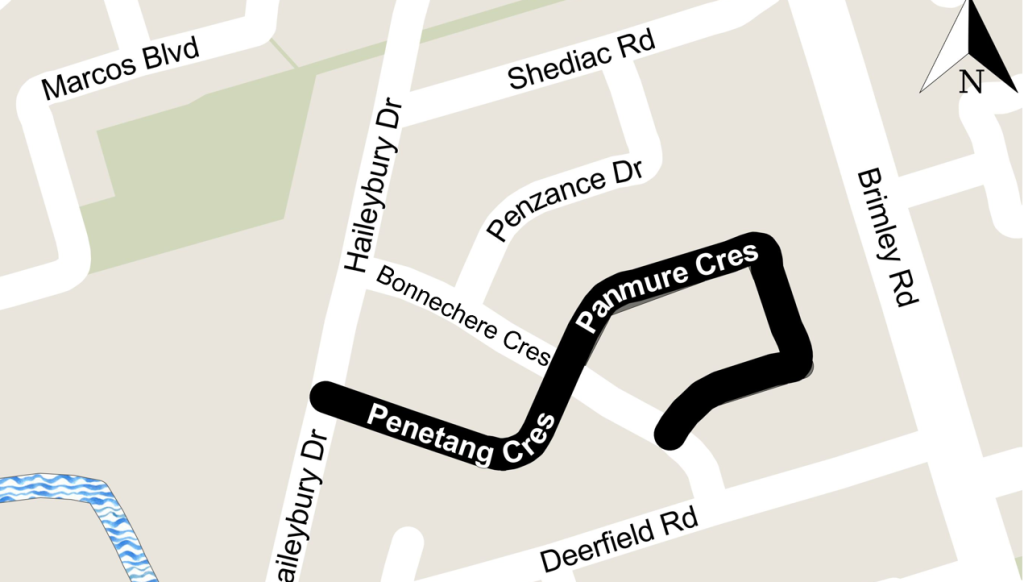
The City of Toronto invited residents to learn more about new sidewalk and accessibility upgrades on Panmure Crescent between Bonnechere Crescent and Bonnechere Crescent and on Penetang Crescent between Haileybury Drive and Bonnechere Crescent, which were proposed as part of planned road resurfacing work in the fall 2023.
Panmure Crescent and Penetang Crescent are classified as local streets, which are streets that typically moves a low to moderate amount of motor vehicle traffic.
The proposed sidewalks aligned with City Council adopted policy which requires sidewalks on one or both sides of local streets to connect existing gaps in neighbourhood sidewalk networks and to provide a safe and accessible place for pedestrians. The goal of the proposed sidewalks is to improve safety and accessibility, particularly in the winter months when roads are icy, pavement width is narrowed by snow, and with daylight hours reduced, the walking conditions are less safe than roadways with sidewalks. Sidewalks would also provide a safe route for children to access Hunter’s Glen Junior Public School and Charles Gordon Senior Public School.
This item was considered by the Infrastructure and Environment Committee on April 26, 2023 and was adopted with amendments.
The Infrastructure and Environment Committee recommends that:
8. City Council request the General Manager, Transportation Services to continue with the planned delivery of sidewalks on:
o. Panmure Crescent (north side from Bonnechere Crescent to Bonnechere Crescent);
p. Penetang Crescent (south/east side from Haileybury Drive to Bonnechere Crescent);
This item was considered by City Council on May 10, 2023 and as adopted with amendments.
Motions (City Council)
9. City Council request the General Manager, Transportation Services, to consider the planned delivery of sidewalks on Panmure Crescent and Penetang Crescent, in parts 8.o. and 8.p. above, at a later time, after the installation of sidewalks on Deerfield Road and Haileybury Drive.

The project area is the north side of Panmure Crescent between Bonnechere Crescent and Bonnechere Crescent and the north side of Penetang Crescent between Haileybury Drive and Bonnechere Crescent.
While we aim to provide fully accessible content, there is no text alternative available for some of the content on this site. If you require alternate formats or need assistance understanding our maps, drawings, or any other content, please contact us at newsidewalks@toronto.ca.
The primary focus of road resurfacing is to maintain a state of good repair and improve the driving surface. Road resurfacing involves replacing the old asphalt surface with a new asphalt surface and provides an opportunity to improve safety for road users.
The project included:
A Virtual Public Meeting was held on April 18, 2023. This was an opportunity for area residents to learn about the project, provide feedback and ask questions.
Provision of safe, comfortable and accessible sidewalks on all public streets is a fundamental objective of the Vision Zero 2.0 Road Safety Plan. Sidewalks support safety, accessibility, affordable transportation, physical activity, safe routes to school, aging in place and sustainable growth. These themes are reflected in the City’s Official Plan (2004), Pedestrian Charter (2002), Walking Strategy (2009), Seniors Strategy (2013), Healthy Streets (2014), Road Safety Plan (2016), and Vision Zero 2.0 Road Safety Plan Update (2019), among others. Local roads remain the largest gap in the walking network and generate the highest number of requests for new sidewalk installations.
Nearly one quarter of all local roads in Toronto, or 800 kilometres, are without a sidewalk. Most local roads have residential land uses, and where sidewalks are missing, pedestrians have no alternative but to walk on the roadway or on unpaved road shoulders. Learn more about the City’s Missing Sidewalks program.